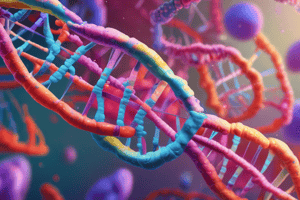Podcast
Questions and Answers
What is genetics?
What is genetics?
The study of biological information
Who discovered DNA?
Who discovered DNA?
Friedrich Miescher
What are the four nitrogen bases of DNA?
What are the four nitrogen bases of DNA?
- Cytosine (C) (correct)
- Adenine (A) (correct)
- Thymine (T) (correct)
- Guanine (G) (correct)
Nuclear DNA contains _______ of DNA.
Nuclear DNA contains _______ of DNA.
Nuclear DNA in somatic cells is _______ for sperm and egg cells.
Nuclear DNA in somatic cells is _______ for sperm and egg cells.
Match the type of DNA to its location:
Match the type of DNA to its location:
DNA is made up of amino acids.
DNA is made up of amino acids.
What is the study of biological information called?
What is the study of biological information called?
Who discovered DNA?
Who discovered DNA?
Nuclear DNA of somatic (body) cells contains _______ of DNA (i.e. ___ sets of chromosomes) — one from father, one from mother.
Nuclear DNA of somatic (body) cells contains _______ of DNA (i.e. ___ sets of chromosomes) — one from father, one from mother.
Sperm and egg cells (gametes) have a ________ number of DNA sets.
Sperm and egg cells (gametes) have a ________ number of DNA sets.
Match the following types of DNA with their locations:
Match the following types of DNA with their locations:
What are the four nitrogen bases in DNA?
What are the four nitrogen bases in DNA?
DNA is only found in the nucleus of eukaryotic cells.
DNA is only found in the nucleus of eukaryotic cells.
What determines the sequence of amino acids in proteins?
What determines the sequence of amino acids in proteins?
Flashcards are hidden until you start studying
Study Notes
Introduction to Genetics
- Genetics is the study of biological information, encompassing the mechanisms and processes that govern genetic traits and diversity among living organisms.
DNA: The Fundamental Information Molecule
- DNA (Deoxyribonucleic acid) is a macromolecule that belongs to nucleic acids and is composed of nucleotides.
- DNA contains the genetic information required for synthesizing proteins.
- The structure of DNA includes four nitrogen bases: guanine (G), adenine (A), cytosine (C), and thymine (T), along with a deoxyribose sugar and phosphate group.
- Complementary base pairing occurs between G-C and A-T through hydrogen bonds, forming the double helix structure of DNA, which exhibits antiparallel orientation.
Proteins: Functional Molecules
- Proteins are macromolecules made up of amino acids, whose sequences are determined by the DNA sequence of genes.
Biological Systems
- Biological systems involve networks of interactions among molecules or groups of cells that work together to perform coordinated functions.
Historical Context
- Friedrich Miescher discovered DNA in 1869, isolating nuclein, which he identified as a phosphorus-rich acidic substance in cell nuclei.
DNA Locations Within Cells
- Nuclear DNA (nDNA) resides in the nucleus of eukaryotic cells.
- Mitochondrial DNA (mtDNA) is located within the mitochondria.
- Chloroplast DNA (cpDNA) is found in plant cell chloroplasts.
Chromosomal Structure
- Nuclear DNA in somatic (body) cells contains two sets of chromosomes (diploid, 2n)—one set inherited from each parent.
- Gametes (sperm and egg cells) contain a single set of chromosomes (haploid, n).
- Plastid DNA (mtDNA and cpDNA) also consists of a single set of chromosomes, typically inherited maternally.
Modern Genetics
- Advances in genetics have led to modern techniques that enhance understanding of DNA, including genetic mapping, sequencing, and gene editing.
Course Administration
- Lecture hours: Tuesday & Thursday, 3:30 PM to 4:20 PM in C6 – 0005.
- Office hours: Tuesday, 1 PM to 2 PM in C6 – 2043, or by appointment (2 days in advance) with Dr. Haslina Razali.
Introduction to Genetics
- Genetics is the study of biological information, encompassing the mechanisms and processes that govern genetic traits and diversity among living organisms.
DNA: The Fundamental Information Molecule
- DNA (Deoxyribonucleic acid) is a macromolecule that belongs to nucleic acids and is composed of nucleotides.
- DNA contains the genetic information required for synthesizing proteins.
- The structure of DNA includes four nitrogen bases: guanine (G), adenine (A), cytosine (C), and thymine (T), along with a deoxyribose sugar and phosphate group.
- Complementary base pairing occurs between G-C and A-T through hydrogen bonds, forming the double helix structure of DNA, which exhibits antiparallel orientation.
Proteins: Functional Molecules
- Proteins are macromolecules made up of amino acids, whose sequences are determined by the DNA sequence of genes.
Biological Systems
- Biological systems involve networks of interactions among molecules or groups of cells that work together to perform coordinated functions.
Historical Context
- Friedrich Miescher discovered DNA in 1869, isolating nuclein, which he identified as a phosphorus-rich acidic substance in cell nuclei.
DNA Locations Within Cells
- Nuclear DNA (nDNA) resides in the nucleus of eukaryotic cells.
- Mitochondrial DNA (mtDNA) is located within the mitochondria.
- Chloroplast DNA (cpDNA) is found in plant cell chloroplasts.
Chromosomal Structure
- Nuclear DNA in somatic (body) cells contains two sets of chromosomes (diploid, 2n)—one set inherited from each parent.
- Gametes (sperm and egg cells) contain a single set of chromosomes (haploid, n).
- Plastid DNA (mtDNA and cpDNA) also consists of a single set of chromosomes, typically inherited maternally.
Modern Genetics
- Advances in genetics have led to modern techniques that enhance understanding of DNA, including genetic mapping, sequencing, and gene editing.
Course Administration
- Lecture hours: Tuesday & Thursday, 3:30 PM to 4:20 PM in C6 – 0005.
- Office hours: Tuesday, 1 PM to 2 PM in C6 – 2043, or by appointment (2 days in advance) with Dr. Haslina Razali.
Studying That Suits You
Use AI to generate personalized quizzes and flashcards to suit your learning preferences.




